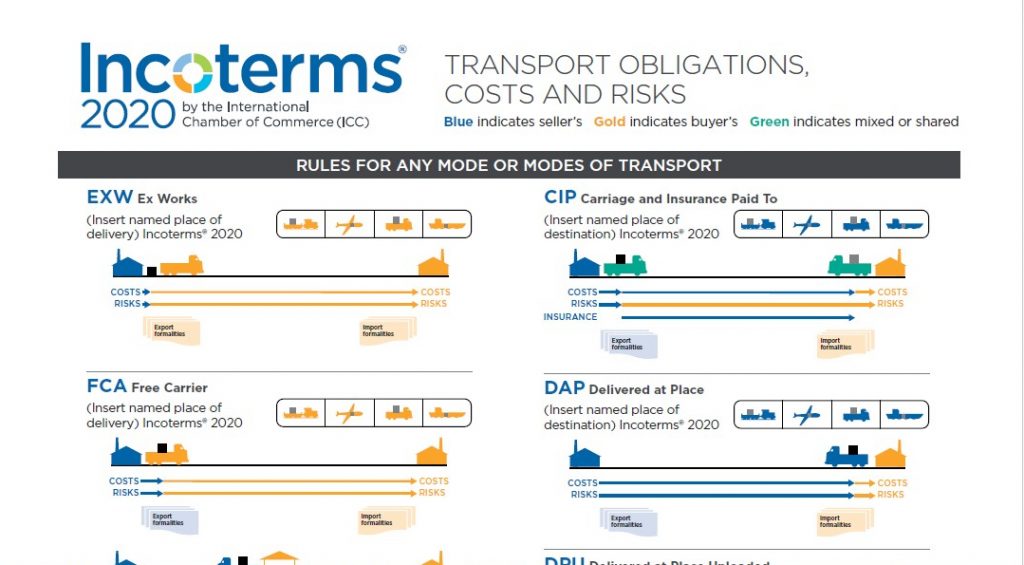This latest version of the International Chamber of Commerce’s (ICC) interpretations of the most common three letter trade abbreviations follow on from previous versions, largely reflecting contractual obligations of the seller and buyer to each other.
Here I have summarised some of the essential things you need to know to use the Incoterms® 2020 correctly, on how point of delivery, transfer of risk, mode of transport and cost vary across the 11 different rules:
Point of Delivery
Firstly, each rule tells us where delivery from the seller to the buyer takes place in a contractual sense, which is not necessarily where the goods pass directly into the buyer’s hands.
- EXW (Ex Works, which is best avoided for a number of reasons), requires the buyer to collect the goods from the seller;
- FCA (Free Carrier), CPT (Carriage Paid To) and CIP (Carriage and Insurance Paid to) require the seller to deliver the goods to the carrier;
- DAP (Delivered at Place) and DDP (Delivered Duty Paid which is also best avoided) require the buyer to unload at the destination and the new DPU (Delivered at Place Unloaded) require the seller to unload at that point;
- FAS (Free Alongside Ship) the seller places the goods alongside the vessel;
- FOB (Free on Board), CFR (Cost and Freight) and CIF (Cost Insurance and Freight) the seller must place the goods on board the vessel.
Transfer of Risk
The risk of loss of, or damage to, the goods passes from the seller to the buyer at the same point and time as delivery. In only two of the rules, CIP (Carriage and Insurance Paid To) and CIF (Cost Insurance and Freight) is there an obligation by the seller to provide the buyer with insurance for its risk. In all other rules the seller bears the risks until delivery and the buyer bears them afterwards.
In the C rules and the D rules the seller must contract for freight to the destination place or port, only in the E and F rules does the buyer arrange freight.
Mode of Transport
Seven of the rules do not actually mention the mode of transport, which can be any one or more of road, rail, air and sea. Four of the rules – FAS (Free Alongside Ship), FOB (Free on Board), CFR (Cost and Freight), CIF (Cost Insurance and Freight) – are the old traditional ones harking back to the days of sailing ships and still are only intended for port to port shipments meaning bulk or break-bulk. These four are not suitable for container shipments in their current form.
Cost
Another matter dealt with in these rules is cost:
– In the E, F and D rules any cost incurred before delivery is for the seller, any cost incurred after delivery is for the buyer.
– The C rules are different in that as well as costs incurred before delivery the seller also pays the costs of getting the goods to their destination and in CIP and CIF also pays the insurance premium.
Custom Obligations
Customs matters are dealt with too. In all but EXW the seller must carry out export formalities, and in all but DDP the buyer must carry out import formalities. Should there be a need for customs formalities in a transit country, then if this occurs before delivery in the D rules then they are for the seller, but in all other rules they are for the buyer.
In this modern world regrettably, security is front-of-mind, and the rules now lay out who has responsibility for security matters at what point, and that the other party must assist with information.
As in life, so it is in the Incoterms® 2020 rules, you get nothing for free. So, while an EXW price would be the lowest, just being the cost of the goods themselves at the seller’s premises, the buyer will need to pay all other costs to bring the goods to its destination. Sometimes traders think that it is cheaper for them to have the seller look after much of the logistics, but the cost of doing so will be reflected in the selling price and most likely with a margin for error as well as a profit margin built in.
As I said at the start, the Incoterms® 2020 rules deal with contractual obligations. But how do they work in the real world of trade? More on this to be continued in the upcoming article…
The best place to start is our Incoterms® 2020 Certificate, the only online course on the new rules that is fully endorsed by the ICC. Our course was written and reviewed by members of the ICC Incoterms® 2020 Drafting Group – make sure you learn from an authentic, legitimate source.
Incoterms® 2020 Wallchart

To get your free copy of the ICC Incoterms® 2020 A4 wallchart that outlines the obligations, costs and risks of the buyer and seller under each of the 11 Incoterms® rules, click the button below. This handy chart can be easily printed and kept as a reference guide.
About the author
This is a guest post from Bob Ronai, first Australian and only the second non-lawyer to be invited by the ICC to be a member of their Incoterms® Drafting Group to draft the new Incoterms® 2020. Over the years, Mr Ronai has established himself as an Incoterms® rules social media influencer on LinkedIn. As the owner of the highly successful INCOTERMS Linkedin Group, Mr Ronai has addressed common questions and misconceptions on the Incoterms® rules. The group boasts of over 20,000 members from a wide variety of professional and geographical backgrounds.
Please note this is an opinion piece and Mr Ronai’s views do not necessarily represent the views of ICC or the ICC Academy. For any clarification regarding the rules we recommend you take the official Incoterms® 2020 Certificate or purchase the Incoterms® 2020 Publication from the ICC. If you have any comments on this article, please feel free to reach out to Mr Ronai

